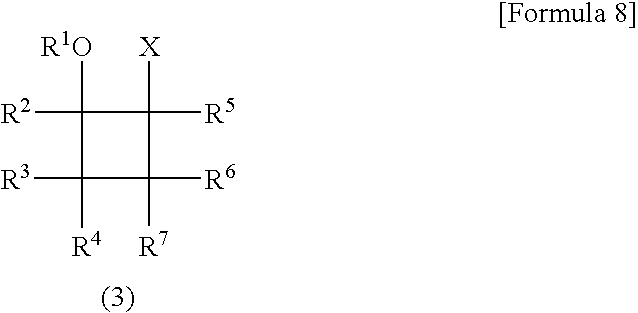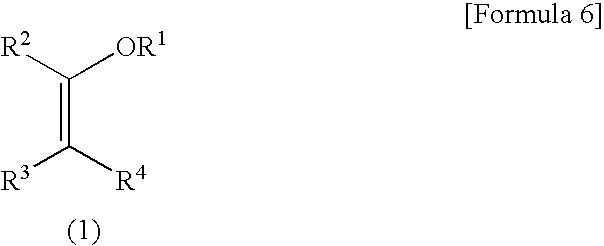Process for Production of Polysubstituted Cyclobutanes and Polysubstituted Cyclobutenes
a technology of cyclobutane and cyclobutene, which is applied in the field of production of polysubstituted cyclobutanes and polysubstituted cyclobutenes, can solve the problems of insufficient use of cyclobutane species, inability to reduce the number of cyclobutane species, etc., to achieve excellent stereoselectivity
- Summary
- Abstract
- Description
- Claims
- Application Information
AI Technical Summary
Benefits of technology
Problems solved by technology
Method used
Image
Examples
working example 1
[0059] Manufacture of polysubstituted cyclobutane compound 3b
[0060] In an argon atmosphere, a methylene chloride solvent (10 mL) of 1-tert-butyldimethylsiloxy-2-methyl-1-cyclohexene (1b: 622 mg, 2.75 mmol) and methyl acrylate (2a: 225 μL, 2.5 mmol) was cooled to −78° C., bis(trifluoromethane)sulfonimide (0.08 M toluene solution, 31 μL, 2.5 μmol) was dripped into the solution, and the solution was stirred for two hours at the same temperature. A saturated bicarbonate solution was added to the reaction solution, and extraction was then performed using hexane. After the organic layer was dried using magnesium sulfate, the product was condensed using an evaporator. The residue was purified by silica gel chromatography (hexane:diethyl ether=50:1), and (1R*,6S*,8R)-1-(tert-butyldimethylsiloxy)-8-methoxycarbonyl-6-methylbicyclo[4.2.0]octane (compound trans-3b) was obtained.
[0061] Yield: 766 mg, yield ratio: 98%, diastereoselectivity: 100%. Table 1 also shows the results obtained when bis...
working example 2
[0067] Table 1 below shows the product, yield ratio, and diastereomer ratio when 1 mol % of bis(trifluoromethane)sulfonimide was reacted with enol ethers 1a through 1f and alkene compounds 2a through 2c in a methylene chloride solvent.
[0068] In Table 1, TBS=tert-butyldimethylsilyl group, Me=methyl group, Ph=phenyl group, and iPr=isopropyl group.
TABLE 1Yield ratio and stereoselectivity of a polysubstituted cyclobutane compoundTotalDiastereomerStarting materialsProducts (cyclobutane)yieldratioEnol ethersAlkeneTrans isomersCis isomersratio(trans:cis)1a2a3a77100:0 1b2a3b92100:0 1c2a3c7080:201d2a3d9193:7 1e2a3e9381:191f2a3f7572:281d2b3g7187:131d2c3h7567:33
[0069] The spectral data of the compounds obtained in the abovementioned working examples are shown below.
[0070] trans-3a
[0071] Colorless oily substance; IR (neat) 1738 cm−1; 1H NMR (600 MHz, CDCl3) δ 3.15 (s, 3H) 2.94 (t, J=7.8 Hz, 1H), 2.57 (m, 2H), 1.86 (m, 2H), 1.75 (m, 2H), 1.57 (m, 1H), 1.50 (d, J=6.6 Hz, 1H), 1.22 (m, 1H), 0...
working example 3
[0087] In an argon atmosphere, an ethyl acetate solution (25 mL) of 1-tert-butyldimethylsiloxy-1-cycloheptene (1d: 5.75 g, 25.4 mmol) and methyl acrylate (2a: 2.18 mL, 24.2 mmol) was cooled to 0° C., bis(trifluoromethane)sulfonimide (0.08 M toluene solution, 1.5 mL, 120 mmol) was dripped into the solution, and the solution was stirred for 30 minutes from the temperature of 0° C. to room temperature. A saturated bicarbonate solution was added to the reaction solution, and extraction was then performed using hexane. After the organic layer was dried using magnesium sulfate, the product was condensed using an evaporator. The residue was purified by silica gel chromatography (hexane:diethyl ether=50:1), and (1R*,7S*,9R*)-1-(tert-butyldimethylsiloxy)-9-methoxycarbonyl-bicyclo[5.2.0]nonane (compound trans-3d) was obtained.
[0088] Yield: 7.5 g, yield ratio: 94%, diastereoselectivity: 97:3 (trans:cis).
[0089] As is apparent from the working example described above, the cyclobutane compound ...
PUM
 Login to View More
Login to View More Abstract
Description
Claims
Application Information
 Login to View More
Login to View More - R&D
- Intellectual Property
- Life Sciences
- Materials
- Tech Scout
- Unparalleled Data Quality
- Higher Quality Content
- 60% Fewer Hallucinations
Browse by: Latest US Patents, China's latest patents, Technical Efficacy Thesaurus, Application Domain, Technology Topic, Popular Technical Reports.
© 2025 PatSnap. All rights reserved.Legal|Privacy policy|Modern Slavery Act Transparency Statement|Sitemap|About US| Contact US: help@patsnap.com



